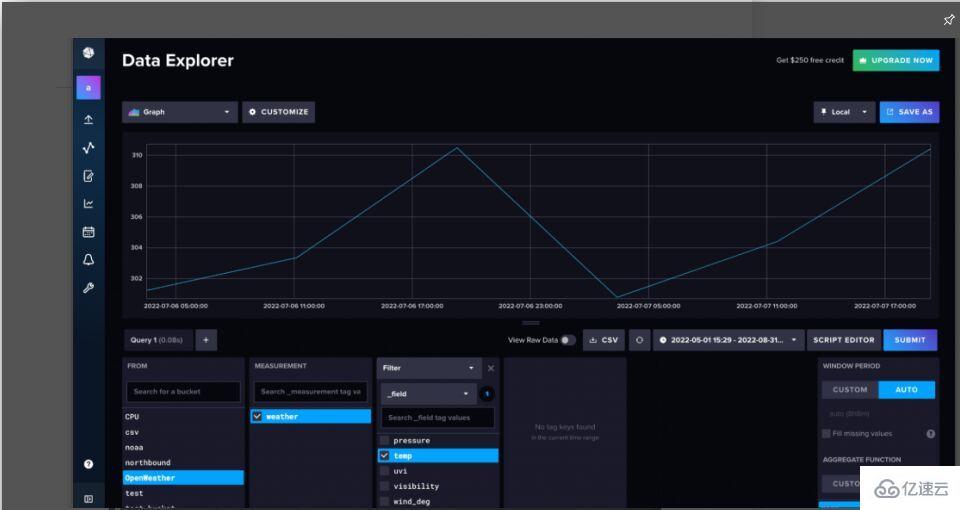жӮЁеҘҪпјҢзҷ»еҪ•еҗҺжүҚиғҪдёӢи®ўеҚ•е“ҰпјҒ
жӮЁеҘҪпјҢзҷ»еҪ•еҗҺжүҚиғҪдёӢи®ўеҚ•е“ҰпјҒ
д»ҠеӨ©е°Ҹзј–з»ҷеӨ§е®¶еҲҶдә«дёҖдёӢжҖҺд№Ҳз”ЁPythonиҺ·еҸ–е’ҢеӯҳеӮЁж—¶й—ҙеәҸеҲ—ж•°жҚ®зҡ„зӣёе…ізҹҘиҜҶзӮ№пјҢеҶ…е®№иҜҰз»ҶпјҢйҖ»иҫ‘жё…жҷ°пјҢзӣёдҝЎеӨ§йғЁеҲҶдәәйғҪиҝҳеӨӘдәҶи§Јиҝҷж–№йқўзҡ„зҹҘиҜҶпјҢжүҖд»ҘеҲҶдә«иҝҷзҜҮж–Үз« з»ҷеӨ§е®¶еҸӮиҖғдёҖдёӢпјҢеёҢжңӣеӨ§е®¶йҳ…иҜ»е®ҢиҝҷзҜҮж–Үз« еҗҺжңүжүҖ收иҺ·пјҢдёӢйқўжҲ‘们дёҖиө·жқҘдәҶи§ЈдёҖдёӢеҗ§гҖӮ
жң¬ж•ҷзЁӢеңЁйҖҡиҝҮHomebrewе·Іе®үиЈ…Python 3зҡ„macOSзі»з»ҹдёҠе®ҢжҲҗгҖӮе»әи®®е®үиЈ…йўқеӨ–зҡ„е·Ҙе…·пјҢжҜ”еҰӮvirtualenvгҖҒpyenvжҲ–conda-envпјҢд»Ҙз®ҖеҢ–Pythonе’ҢClientзҡ„е®үиЈ…гҖӮе®Ңж•ҙзҡ„иҰҒжұӮеңЁиҝҷйҮҢпјҡ
txt influxdb-client=1.30.0 pandas=1.4.3 requests>=2.27.1
жң¬ж•ҷзЁӢиҝҳеҒҮи®ҫжӮЁе·Із»ҸеҲӣе»әFree Tier InfluxDBдә‘еёҗжҲ·жҲ–жӯЈеңЁдҪҝз”ЁInfluxDB OSSпјҢжӮЁд№ҹе·Із»Ҹпјҡ
еҲӣе»әдәҶеӯҳеӮЁжЎ¶гҖӮжӮЁеҸҜд»Ҙе°ҶеӯҳеӮЁжЎ¶и§Ҷдёәж•°жҚ®еә“жҲ–InfluxDBдёӯжңҖй«ҳеұӮж¬Ўзҡ„ж•°жҚ®з»„з»ҮгҖӮ
еҲӣе»әдәҶд»ӨзүҢгҖӮ
жңҖеҗҺпјҢиҜҘж•ҷзЁӢиҰҒжұӮжӮЁе·Із»ҸдҪҝз”ЁOpenWeatherMapеҲӣе»әдәҶдёҖдёӘеёҗжҲ·пјҢ并已еҲӣе»әдәҶд»ӨзүҢгҖӮ
йҰ–е…ҲпјҢжҲ‘们йңҖиҰҒиҜ·жұӮж•°жҚ®гҖӮжҲ‘们е°ҶдҪҝз”ЁиҜ·жұӮеә“пјҢйҖҡиҝҮOpenWeatherMap APIд»ҺжҢҮе®ҡзҡ„з»ҸеәҰе’Ңзә¬еәҰиҝ”еӣһжҜҸе°Ҹж—¶зҡ„еӨ©ж°”ж•°жҚ®гҖӮ
# Get time series data from OpenWeatherMap API
params = {'lat':openWeatherMap_lat, 'lon':openWeatherMap_lon, 'exclude':
"minutely,daily", 'appid':openWeatherMap_token}
r = requests.get(openWeather_url, params = params).json()
hourly = r['hourly']жҺҘдёӢжқҘпјҢе°ҶJSONж•°жҚ®иҪ¬жҚўжҲҗPandas DataFrameгҖӮжҲ‘们иҝҳе°Ҷж—¶й—ҙжҲід»Һз§’зІҫеәҰзҡ„Unixж—¶й—ҙжҲіиҪ¬жҚўжҲҗж—Ҙжңҹж—¶й—ҙеҜ№иұЎгҖӮд№ӢжүҖд»ҘиҝӣиЎҢиҝҷз§ҚиҪ¬жҚўпјҢжҳҜз”ұдәҺInfluxDBеҶҷе…Ҙж–№жі•иҰҒжұӮж—¶й—ҙжҲідёәж—Ҙжңҹж—¶й—ҙеҜ№иұЎж јејҸгҖӮжҺҘдёӢжқҘпјҢжҲ‘们е°ҶдҪҝз”Ёиҝҷз§Қж–№жі•пјҢе°Ҷж•°жҚ®еҶҷе…ҘеҲ°InfluxDBгҖӮжҲ‘们иҝҳеҲ йҷӨдәҶдёҚжғіеҶҷе…ҘеҲ°InfluxDBзҡ„еҲ—гҖӮ
python # Convert data to Pandas DataFrame and convert timestamp to datetime object df = pd.json_normalize(hourly) df = df.drop(columns=['weather', 'pop']) df['dt'] = pd.to_datetime(df['dt'], unit='s') print(df.head)
зҺ°еңЁдёәInfluxDB Pythonе®ўжҲ·з«Ҝеә“еҲӣе»әе®һдҫӢпјҢ并е°ҶDataFrameеҶҷе…ҘеҲ°InfluxDBгҖӮжҲ‘们жҢҮе®ҡдәҶжөӢйҮҸеҗҚз§°гҖӮжөӢйҮҸеҗ«жңүеӯҳеӮЁжЎ¶дёӯзҡ„ж•°жҚ®гҖӮжӮЁеҸҜд»Ҙе°Ҷе…¶и§ҶдёәInfluxDBзҡ„ж•°жҚ®з»„з»Үдёӯд»…ж¬ЎдәҺеӯҳеӮЁжЎ¶зҡ„第дәҢй«ҳеұӮж¬Ўз»“жһ„гҖӮ
жӮЁиҝҳеҸҜд»ҘдҪҝз”Ёdata_frame__tag_columnsеҸӮж•°жҢҮе®ҡе°Ҷе“ӘдәӣеҲ—иҪ¬жҚўжҲҗж ҮзӯҫгҖӮ
з”ұдәҺжҲ‘们没жңүе°Ҷд»»дҪ•еҲ—жҢҮе®ҡдёәж ҮзӯҫпјҢжҲ‘们зҡ„жүҖжңүеҲ—йғҪе°ҶиҪ¬жҚўжҲҗInfluxDBдёӯзҡ„еӯ—ж®өгҖӮж Үзӯҫз”ЁдәҺеҶҷе…Ҙжңүе…іжӮЁзҡ„ж—¶й—ҙеәҸеҲ—ж•°жҚ®зҡ„е…ғж•°жҚ®пјҢеҸҜз”ЁдәҺжӣҙжңүж•Ҳең°жҹҘиҜўж•°жҚ®еӯҗйӣҶгҖӮеӯ—ж®өжҳҜжӮЁеңЁ InfluxDBдёӯеӯҳеӮЁе®һйҷ…ж—¶й—ҙеәҸеҲ—ж•°жҚ®зҡ„дҪҚзҪ®гҖӮ
on # Write data to InfluxDB with InfluxDBClient(url=url, token=token, org=org) as client: df = df client.write_api(write_options=SYNCHRONOUS).write(bucket=bucket,record=df, data_frame_measurement_name="weather", data_frame_timestamp_column="dt")
еӣһйЎҫдёҖдёӢпјҢдёҚеҰЁзңӢзңӢе®Ңж•ҙзҡ„и„ҡжң¬гҖӮ жҲ‘们йҮҮеҸ–д»ҘдёӢжӯҘйӘӨпјҡ
1. еҜје…Ҙеә“гҖӮ
2. 收йӣҶд»ҘдёӢеҶ…е®№пјҡ
InfluxDBеӯҳеӮЁжЎ¶
InfluxDBз»„з»Ү
InfluxDBд»ӨзүҢ
InfluxDB URL
OpenWeatherMap URL
OpenWeatherMap д»ӨзүҢ
3. еҲӣе»әиҜ·жұӮгҖӮ
4. е°ҶJSONе“Қеә”иҪ¬жҚўжҲҗPandas DataFrameгҖӮ
5. еҲ йҷӨжӮЁдёҚжғіеҶҷе…ҘеҲ°InfluxDBзҡ„д»»дҪ•еҲ—гҖӮ
6. е°Ҷж—¶й—ҙжҲіеҲ—д»ҺUnixж—¶й—ҙиҪ¬жҚўжҲҗPandasж—Ҙжңҹж—¶й—ҙеҜ№иұЎгҖӮ
7. дёәInfluxDB Python Clientеә“еҲӣе»әе®һдҫӢгҖӮ
8. зј–еҶҷDataFrameпјҢ并жҢҮе®ҡжөӢйҮҸеҗҚз§°е’Ңж—¶й—ҙжҲіеҲ—гҖӮ
python
import requests
import influxdb_client
import pandas as pd
from influxdb_client import InfluxDBClient
from influxdb_client.client.write_api import SYNCHRONOUS
bucket = "OpenWeather"
org = "" # or email you used to create your Free Tier
InfluxDB Cloud account
token = "
url = "" # for example,
https://us-west-2-1.aws.cloud2.influxdata.com/
openWeatherMap_token = ""
openWeatherMap_lat = "33.44"
openWeatherMap_lon = "-94.04"
openWeather_url = "https://api.openweathermap.org/data/2.5/onecall"
# Get time series data from OpenWeatherMap API
params = {'lat':openWeatherMap_lat, 'lon':openWeatherMap_lon, 'exclude':
"minutely,daily", 'appid':openWeatherMap_token}
r = requests.get(openWeather_url, params = params).json()
hourly = r['hourly']
# Convert data to Pandas DataFrame and convert timestamp to datetime
object
df = pd.json_normalize(hourly)
df = df.drop(columns=['weather', 'pop'])
df['dt'] = pd.to_datetime(df['dt'], unit='s')
print(df.head)
# Write data to InfluxDB
with InfluxDBClient(url=url, token=token, org=org) as client:
df = df
client.write_api(write_options=SYNCHRONOUS).write(bucket=bucket,record=df,
data_frame_measurement_name="weather",
data_frame_timestamp_column="dt")зҺ°еңЁпјҢжҲ‘们已з»Ҹе°Ҷж•°жҚ®еҶҷе…ҘеҲ°InfluxDBпјҢеҸҜд»ҘдҪҝз”ЁInfluxDB UIжқҘжҹҘиҜўж•°жҚ®дәҶгҖӮеҜјиҲӘеҲ°ж•°жҚ®иө„жәҗз®ЎзҗҶеҷЁ(д»Һе·Ұдҫ§еҜјиҲӘж Ҹдёӯ)гҖӮдҪҝз”ЁQuery Builder(жҹҘиҜўжһ„е»әеҷЁ)пјҢйҖүжӢ©жғіиҰҒеҸҜи§ҶеҢ–зҡ„ж•°жҚ®е’ҢжғіиҰҒдёәд№ӢеҸҜи§ҶеҢ–зҡ„иҢғеӣҙпјҢ然еҗҺзӮ№еҮ»вҖңжҸҗдәӨвҖқгҖӮ

еӣҫ1. еӨ©ж°”ж•°жҚ®зҡ„й»ҳи®Өзү©еҢ–и§ҶеӣҫгҖӮInfluxDBиҮӘеҠЁиҒҡеҗҲж—¶й—ҙеәҸеҲ—ж•°жҚ®пјҢиҝҷж ·ж–°з”ЁжҲ·е°ұдёҚдјҡж„ҸеӨ–жҹҘиҜўеӨӘеӨҡж•°жҚ®иҖҢеҜјиҮҙи¶…ж—¶
дё“дёҡжҸҗзӨәпјҡеҪ“жӮЁдҪҝз”ЁжҹҘиҜўжһ„е»әеҷЁжҹҘиҜўж•°жҚ®ж—¶пјҢInfluxDBиҮӘеҠЁеҜ№ж•°жҚ®иҝӣиЎҢдёӢйҮҮж ·гҖӮиҰҒжҹҘиҜўеҺҹе§Ӣж•°жҚ®пјҢеҜјиҲӘеҲ°Script Editor(и„ҡжң¬зј–иҫ‘еҷЁ)д»ҘжҹҘзңӢеә•еұӮFluxжҹҘиҜўгҖӮFluxжҳҜйқўеҗ‘InfluxDBзҡ„еҺҹз”ҹжҹҘиҜўе’Ңи„ҡжң¬иҜӯиЁҖпјҢеҸҜз”ЁдәҺдҪҝз”ЁжӮЁзҡ„ж—¶й—ҙеәҸеҲ—ж•°жҚ®жқҘеҲҶжһҗе’ҢеҲӣе»әйў„жөӢгҖӮдҪҝз”ЁaggregateWindow()еҮҪж•°еҸ–ж¶ҲиЎҢжіЁйҮҠжҲ–еҲ йҷӨиЎҢпјҢд»ҘжҹҘзңӢеҺҹе§Ӣж•°жҚ®гҖӮ

еӣҫ2. еҜјиҲӘеҲ°и„ҡжң¬зј–иҫ‘еҷЁпјҢ并еҸ–ж¶ҲжіЁйҮҠжҲ–еҲ йҷӨaggregateWindow()еҮҪж•°пјҢд»ҘжҹҘзңӢеҺҹе§ӢеӨ©ж°”ж•°жҚ®
д»ҘдёҠе°ұжҳҜвҖңжҖҺд№Ҳз”ЁPythonиҺ·еҸ–е’ҢеӯҳеӮЁж—¶й—ҙеәҸеҲ—ж•°жҚ®вҖқиҝҷзҜҮж–Үз« зҡ„жүҖжңүеҶ…е®№пјҢж„ҹи°ўеҗ„дҪҚзҡ„йҳ…иҜ»пјҒзӣёдҝЎеӨ§е®¶йҳ…иҜ»е®ҢиҝҷзҜҮж–Үз« йғҪжңүеҫҲеӨ§зҡ„收иҺ·пјҢе°Ҹзј–жҜҸеӨ©йғҪдјҡдёәеӨ§е®¶жӣҙж–°дёҚеҗҢзҡ„зҹҘиҜҶпјҢеҰӮжһңиҝҳжғіеӯҰд№ жӣҙеӨҡзҡ„зҹҘиҜҶпјҢиҜ·е…іжіЁдәҝйҖҹдә‘иЎҢдёҡиө„и®Ҝйў‘йҒ“гҖӮ
е…ҚиҙЈеЈ°жҳҺпјҡжң¬з«ҷеҸ‘еёғзҡ„еҶ…е®№пјҲеӣҫзүҮгҖҒи§Ҷйў‘е’Ңж–Үеӯ—пјүд»ҘеҺҹеҲӣгҖҒиҪ¬иҪҪе’ҢеҲҶдә«дёәдё»пјҢж–Үз« и§ӮзӮ№дёҚд»ЈиЎЁжң¬зҪ‘з«ҷз«ӢеңәпјҢеҰӮжһңж¶үеҸҠдҫөжқғиҜ·иҒ”зі»з«ҷй•ҝйӮ®з®ұпјҡis@yisu.comиҝӣиЎҢдёҫжҠҘпјҢ并жҸҗдҫӣзӣёе…іиҜҒжҚ®пјҢдёҖз»ҸжҹҘе®һпјҢе°Ҷз«ӢеҲ»еҲ йҷӨж¶үе«ҢдҫөжқғеҶ…е®№гҖӮ